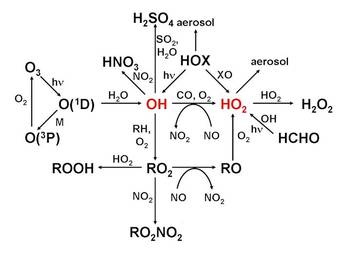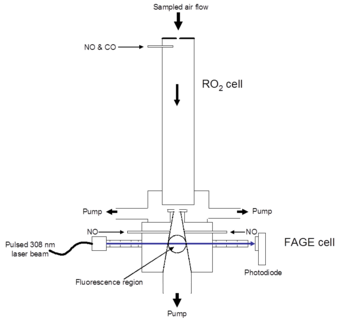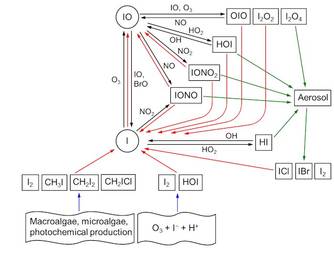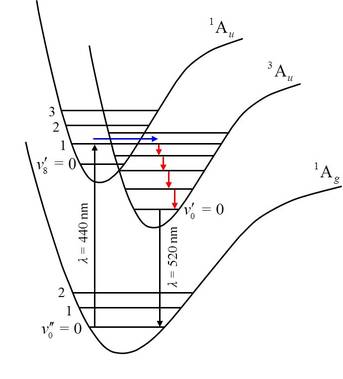Atmospheric Chemistry
This page introduces the atmospheric species measured by the Heard group, and gives a brief description of the techniques involved. Please follow the links on the left hand side for details of the FAGE technique, laboratory and modelling studies, and fieldwork projects.
OH and HO2
The highly reactive hydroxyl radical, OH, is the major oxidising compound in the troposphere, and governs the atmospheric lifetimes of many trace species of biogenic and anthropogenic origin. OH is primarily produced by the photolysis of ozone to form O(1D) followed by reaction with H2O. It is the primary daytime oxidising species responsible for the removal of CO, CH4 (and higher hydrocarbons), H2, NO2, H2S, (CH3)2S, NH3, the hydrochlorofluorocarbons (HCFCs) and hydrofluorocarbons (HFCs). The concentration of OH defines the oxidising capacity of the atmosphere and hence the ability to control levels of species that contribute to global warming, acid rain, and photochemical smog. Intermediate peroxy radicals, of which HO2 is the simplest, are generated during the oxidation of trace gases and a fast photochemical cycle (see diagram below) links these radicals with OH.

OH is highly reactive, with the balance between production and destruction rates giving an atmospheric lifetime under clean conditions of ~1 s (less under polluted conditions), and consequently tropospheric concentrations are extremely low. Daytime maxima are in the range of (1-10) x 106 molecule cm-3 (0.04 - 0.4 pptv). HO2 has a longer lifetime of ~100 s with a typical daytime maximum concentration of ~108 molecule cm-3 (~4 pptV).
The short atmospheric lifetimes of OH and HO2 mean that their concentrations are determined by local chemical conditions, such as solar flux and levels of NOx, rather than transport, making them ideal candidates with which to test our understanding of atmospheric chemistry through measurements and zero-dimensional modelling.
Atmospheric concentrations of OH and HO2 are measured using the FAGE (Fluorescence Assay by Gas Expansion) technique.
OH Reactivity
Discrepancies between measured and calculated (modelled) values of [OH] indicate that our knowledge of the chemical processes occurring in a certain atmospheric environment is incomplete. Comparison of modelled and measured total OH reactivity can reveal the presence of unmeasured sinks of OH, enabling resolution between measured and modelled values of [OH]. The total OH reactivity or loss rate is the inverse of its atmospheric lifetime.
The technique employed for the measurement of total OH reactivity is based on measuring the decay of artificially produced OH in an atmospheric pressure flow tube reactor. The University of Leeds OH reactivity measurement was first employed in the field during the TORCH-2 campaign in Weybourne (see Fieldwork). In the first generation instrument, OH radicals were generated in the tip of a movable injector tube inside a larger diameter flow tube, into which ambient air was drawn. OH radicals were detected by FAGE at the downstream end of the main flow tube. During a measurement cycle, the injector was stepped back in fixed increments to increase the distance between injection and sampling, thus increasing the reaction time between OH and ambient trace gases, with the concentration of OH being measured for each reaction time.
The latest version of the reactivity instrument uses laser light at 266 nm to generate OH radicals along the length of the reaction tube by photolysis of ambient or artificially generated ozone. The FAGE detector is positioned at the downstream end of the flow tube, and the OH decay is recorded in real time as the reaction mixture flows past the FAGE inlet. This reactivity instrument has been designed to be coupled to the HIRAC chamber for the study of atmospheric chemistry of vehicular emissions. The instrument was deployed in the field during the ClearfLo campaign and will be used during a measurement campaign at the University of York.
Organic Peroxy Radicals (RO2)

Organic peroxy radicals, RO2, are produced in the oxidation of volatile organic compounds (VOCs), and are important intermediates in the HOx radical cycle (see diagram above) and in production of tropospheric ozone. As they are a source of OH, atmospheric measurements of RO2 concentrations are key to quantifying the radical budget.
The University of Leeds ground-based FAGE instrument is coupled with a reaction tube to enable atmospheric measurements of RO2. RO2 radicals are converted to OH and HO2 by reaction with NO, O2 and CO. The HOx radicals are then detected by FAGE. This technique is known as ROxLIF. The FAGE/ROxLIF instrument measures the total concentration of RO2 radicals.
The FAGE/ROxLIF instrument was used during the ClearfLo campaign (see Ground-based Fieldwork for more information) and will be used in an upcoming field measurement campaign in York.
Iodine monoxide (IO)

Iodine species are present in the marine boundary layer (MBL) due to the release of I2 and photo-labile iodocarbons from macro- and micro-algae, and photochemical processes at the sea surface. The photolysis of these iodine-containing species yield iodine atoms, which react with ozone to generate IO.
The IO radical plays an important role in the chemistry occurring in the MBL. It has been implicated in catalytic ozone destruction cycles, it influences the oxidising capacity of the region through the perturbation of the HOx cycle, and it is responsible for the formation and growth of new particles.
IO is measured by laser-induced fluorescence, using laser light at 445 nm to excite IO radicals in a detection cell. The resulting fluorescence at 521 nm is detected using a channel photomultiplier tube, in a similar way to the FAGE technique. The Leeds IO Laser-Induced Fluorescence instrument has been deployed on a number of fieldwork campaigns.
Glyoxal

Glyoxal, CHOCHO, is the smallest alpha-dicarbonyl, and is a product of atmospheric oxidation of biogenic and anthropogenic organic compounds, including isoprene and acetylene. Glyoxal is highly soluble in water and plays a role in secondary organic aerosol formation, thereby having an impact on climate. Glyoxal is removed by photolysis, photochemical oxidation, dry deposition, and uptake by aerosol and cloud droplets. The tropospheric lifetime is on the order of 1 to 3 hours. Atmospheric mixing ratios up to 1.8 ppbv have been measured in a polluted urban environment.
A laser-induced phosphorescence instrument for field measurements of glyoxal has been developed by the FAGE group at Leeds. Ambient air is drawn through a detection cell where laser light at ~ 440 nm excites glyoxal from its ground state to its first excited singlet state. Intersystem crossing to the excited triplet state is followed by long-lived phosphorescence at 520 nm, which is detected by a photomultiplier tube. The instrument will be deployed during the Oceanic Reactive Carbon: Climate Impacts (ORC3) project which will take place in Cape Verde in summer and autumn 2014. The ORC3 project aims to address uncertainties in the emission, processing and climate impacts of oceanic carbon through fieldwork and modelling studies.
Formaldehyde
A Fiber Laser-Induced Fluorescence instrument has been built to measure formaldehyde, HCHO, a product of VOC oxidation and a key intermediate in the HOx cycle. Formaldehyde is present throughout the troposphere, being emitted directly from various sources, and photolysis of formaldehyde has been shown to be a significant source of HOx in a number of locations.
The instrument has been used to characterise the new OH reactivity instrument, and will be deployed during upcoming measurement campaigns at the University of Leeds and in York.
